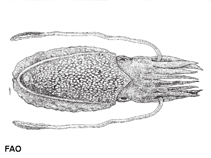Sepiella japonica Sasaki, 1929
Japanese spineless cuttlefish
Classification / Names প্রচলিত নাম সমূহ | প্রতিনাম সমূহ | CoL | ITIS | WoRMS
Cephalopoda | Sepiida | Sepiidae
Environment: milieu / climate zone / গভীরতার পরিসীমা / distribution range বাস্তুসংস্থান
; গভীরতার পরিসীমা 0 - 50 m (সূত্র 1695). Subtropical; 44°N - 22°N, 113°E - 141°E (সূত্র 1695)
Distribution দেশ সমূহ | এফ এ ও এলাকাসমূহ | বাস্তুতন্ত্র | দৃষ্টিগোচর | প্রচলন
Northwest Pacific: Japan to South Korea and China.
Length at first maturity / আকৃতি / Weight / Age
পরিপক্কতা : Lm ? range ? - ? cm Max length : 20.0 cm ML পুরুষ/ লিঙ্গ অনিধর্ারিত ; (সূত্র 275); সবের্াচ্চ প্রকাশিত ওজন : 0.80 g (সূত্র 275)
Short description বহিঃ অঙ্গ সংস্থান
Shell: spineless, cuttlebone width 30 to 35% of length. Mantle: broadly oval, dorsal anterior margin triangular, obtuse; pore of caudal gland at posterior tip ventral to fins. Tentacular clubs elongate, with 20 minute subequal suckers in transverse rows. Arms relatively short. Arm suckers quadriserial; left arm IV hectocotylized in proximal third with the basal part modified by great reduction in size of suckers placed on a transversely ridged surface; ventral 2 rows of suckers close together, dorsal 2 rows separated. Colour: greyish brown. Dorsal mantle covered with white blotches or spots. Fins with pale reflective line along base. No spots or wine-coloured patches at base of fins.
It is a coastal demersal species, with depth up to about 50 m. Dominant cuttlefish caught around the Chekiang and Kiangsu, China. It is also important in the fisheries of Japan, South Korea and Taiwan, caught in large numbers in bottom trawls. In Japan, most of the catch is dried and marketed as ‘surume’ (Ref. 275).
Life cycle and mating behavior পরিপক্কতা | প্রজনন | ডিম ছাড়া | Eggs | ডিম্বধারন ক্ষমতা | Larvae
Members of the class Cephalopoda are gonochoric. Male and female adults usually die shortly after spawning and brooding, respectively. Mating behavior: Males perform various displays to attract potential females for copulation. During copulation, male grasp the female and inserts the hectocotylus into the female's mantle cavity where fertilization usually occurs. Life cycle: Embryos hatch into planktonic stage and live for some time before they grow larger and take up a benthic existence as adults.
Main reference
সূত্র সংখ্যা | সমম্বয়কারী | সহযোগী
Jereb, P. and C.F.E. Roper (eds.). 2005. (সূত্র 1695)
IUCN Red List Status
(সূত্র 130435: Version 2024-2)
Data deficient (DD) ; Date assessed: 19 March 2009
CITES status (সূত্র 108899)
Not Evaluated
CMS (সূত্র 116361)
Not Evaluated
Threat to humans
Human uses
মৎস্য: বাণিজ্যিক
| FishSource |
হাতিয়ার
আরো তথ্য
ট্রফিক বাস্তুতন্ত্র
খাদ্যসামগ্রী
পথ্য উপাদান
খাদ্য গ্রহণ
Food rations
শিকারী প্রাণী সমূহ
পথ্য উপাদান
খাদ্য গ্রহণ
Food rations
শিকারী প্রাণী সমূহ
বাস্তুসংস্থান
Population dynamics
বৃদ্ধি
Max. ages / sizes
Length-weight rel.
Length-length rel.
Length-frequencies
Mass conversion
নির্বাচন
প্রাচুর্য
Max. ages / sizes
Length-weight rel.
Length-length rel.
Length-frequencies
Mass conversion
নির্বাচন
প্রাচুর্য
Life cycle
Distribution
Human Related
Aquaculture profiles
Stamps, coins, misc.
Stamps, coins, misc.
Outreach
সূত্র সংখ্যা
ইন্টারনেট সুত্র
BHL | BOLD Systems | CISTI | DiscoverLife | FAO(Publication : search) | Fishipedia | GenBank (genome, nucleotide) | GloBI | Gomexsi | Google Books | Google Scholar | Google | PubMed | জীবন বৃক্ষ | Wikipedia (Go, অনুসন্ধান ) | জুলজিকাল রেকর্ড



